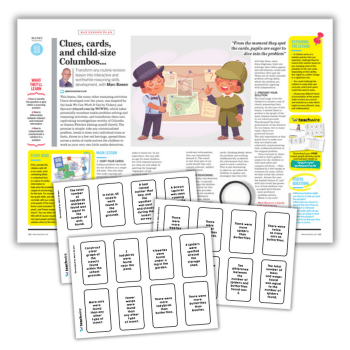Do you teach instruction then problem-solving in primary maths? Or the other way round?

I-PS or PS-I? Is there an answer to this chicken-and-egg scenario? It all depends on what sort of maths you want children to learn, says Mike Askew…

- by Mike Askew
- Educator, researcher and speaker with a focus on primary maths education Visit website

When I started teaching back in the pre-national curriculum stone age, if you asked a teacher about what theory most influenced their teaching, then Piaget and his theory of stages of development would often be mentioned.
In summary, his theory was that how we think goes through distinct, different stages as we get older, with young children’s thinking being tied to actions on concrete objects; actions that over time come to be imagined rather than actually needing to be carried out.
That internalisation, so Piaget argued, led to the ability to reason formally only arising in the early teen years.
While many writers now consider this ’stages’ theory to be flawed – that it underestimates not only the reasoning abilities of young children but also the extent to which adults still rely on concrete images – the theory was commonly assumed to have shaped teaching practices, particularly the use of practical material in the early years of primary school and the delaying of ideas like ratio and proportion to the early secondary years.
Looking back later at the evidence for the influence of Piaget’s theory, Valerie Walkerdine argued that, in fact, the teaching practices and curriculum ordering that were attributed to this theory were actually already in place prior to the English education system ‘discovering’ Piaget.
His theories, it seems, did not lead to the introduction of particular styles of teaching, but were used to justify what was already being done.
Architecture of thinking
Roll forward to 2020 and a theory that now seems highly influential is cognitive load theory, and the associated calls for it implying the need for direct instruction.
Cognitive load theory, to oversimplify it, is grounded in the ‘architecture’ of our thinking having two main components: working memory and long-term memory.
Given the evidence that working memory is limited and can only process around three to five units of information at a time (and then not hold onto them for long), the argument follows that direct instruction, wherein teachers model working through examples, lightens the cognitive load for pupils.
After seeing examples worked through, similar problems are presented that pupils then work through on their own, recreating what they have seen the teacher do. The general model of teaching is thus one of instruction followed by problem solving: I-PS.
An alternative approach flips this sequence – PS-I.
Here, pupils are first given a problem to solve followed by an explicit teaching phase.
This rests on the expectation that pupils will find informal solutions to the problem posed and then the teacher, by comparing and contrasting different pupil solutions, draws out the mathematics, leading the class to the desired solution and approach.
Advocates of the PS-I approach argue that this works because being posed a problem means pupils activate their prior knowledge, that they ‘tune in’ to what is being taught, and that it can make them aware of gaps in their knowledge and so be more receptive to the subsequent teaching.
The ‘productive struggle’ that arises from PS-I means, it is argued, that pupils come to identify and learn the ‘deep’ features of the mathematics being worked on.
Which to choose
So, which is better? I-PS or PS-I? Is there evidence for the effectiveness of one of these approaches over the other? Well, there is no consistent finding. Many studies demonstrate the superiority of I-PS over PS-I but, equally, there are several studies demonstrating that PS-I is the more effective approach.
Given that both approaches appear to have merit, maybe the answer as to which style to adapt simply comes down to an individual teacher’s preference.
I’m reminded of when the national numeracy strategy was introduced and a style of teaching advocated that had the teacher modelling what to do, followed by pupils working on similar examples.
More than once, teachers told me something along the lines of, ‘Now I can teach maths the way I always thought it should be taught’.
It seems many teachers have a strong preference for directly showing pupils what to do, although whether that is based in a view of pupils being mathematically ‘empty vessels’ or the result of how most of us were taught mathematics ourselves is open to debate.
It may be the case that the current popularity of cognitive load theory and direct instruction is like my experience of Piaget; it is being used to justify existing practices.
Drilling down into the research on I-PS v PS-I suggests, however, that it is not as simple as taking your pick. A major review of studies into the effectiveness of each approach by the writers Chen and Kalyuga (2019) shows that there are differences in the sort of learning outcomes arising from each approach.
Their meta-analysis of several undefended studies confirms the view that both instruction followed by problem solving (I-PS) and problem solving then instruction (PS-I), can be effective.
But over and above this, they found that PS-I was more effective in bringing about learning of conceptual knowledge and understanding principles’ underlying procedures, whereas I-PS was better for teaching how to carry out procedures.
So, a key question to ask is what sort of mathematics we actually want our pupils to learn. The answer to the ‘effectiveness’ questions cannot be addressed without being clear about these aims.
In other words, if we want pupils to go beyond being able to carry out procedures and to develop conceptual understanding of the mathematics, then PS-I looks to be the better approach.
Layla’s bracelets
What this difference might look like in practice can be illustrated by looking at the sort of questions from our national tests.
As always, a health warning – I do not advocate ‘teaching to the test’ but do think looking closely at the sorts of questions posed on the tests can help us think about the sort of mathematics we want our pupils to be engaging with.
One of the 2019 reasoning questions gave the following information about making bracelets and necklaces:
Each bracelet has 53 beads Layla makes 68 bracelets Each necklace has 105 beads Layla makes 34 necklaces
The question posed was to work out the number of beads Layla used altogether.
At first glance this looks like a fairly standard two-step word problem: calculate the number of beads used for the bracelets (53 x 68) and the number for the necklaces (105 x 34) and add the two products together.
As such, the solution method can be demonstrated, and then further similar problems be set to practise these two steps.
But a closer look at the set-up of the problem suggests that there might be more behind its design than simply setting up a two-step problem.
The inclusion of 68 followed by 34 looks not to be unintentional. Spotting that 34 is half of 68 might lead to the realisation that 53 x 68 can be transformed into the equivalent calculation of 106 x 34, using the associative rule:
53 x 68 = 53 x (2 x 34) = (53 x 2) x 34 = 106 x 34
The two products can then be combined:
106 x 34 + 105 x 34 = 211 x 34
Now it may be that this reorganisation of the two products into one product is, in the end, not much quicker than simply carrying out the two-step approach.
But being alert to, attuned to and looking for patterns in the calculation, and seeking out a more elegant way of finding the solution, is precisely what makes mathematics appealing to those who go on to study it.
Helping pupils develop such a sensibility, an attunement to looking beyond the surface features of a problem, is, I think, only possible through a PS-I approach.
Setting a problem like this, giving pupils time to work on it and looking out for anyone who spots the connection between 68 and 34, can lead to a rich discussion of the strengths and weaknesses of different approaches.
We do not have to wait until the end of KS2 to encourage pupils to look beyond the immediate features of the problem. The 2019 KS1 assessment presented this series of calculations: 1 + 2 + 3 = 6 2 + 3 + 4 = 9 3 + 4 + 5 = 12 4 + 5 + 6 = 15
Pupils had to complete the next number sentence in the pattern. I would expect that many children would have seen the pattern in the column of addends, to arrive at the next number sentence of:
5 + 6 + 7 = [ ]
I wonder how many of them then went on to calculate the answer to this from scratch? Here, before actually posing the question to be answered I might simply put up on the board the four completed calculations, and ask pupils to talk to a partner about what they notice.
I would be listening out for anyone not just noticing the pattern in the addends, but also the differences of threes in the totals. Can anyone articulate why those answers are going up by three each time? That could the lead into exploring:
1 + 2 + 3 + 4 = 10 2 + 3 + 4 + 5 = 14
Again, posing such questions to a class and then having a conversation about the different things they notice takes us into exploring mathematical generalities, into doing mathematics rather than merely ‘finding the answer’.
Of course, I am not suggesting that the result of such discussions will mean everyone in the class immediately falling in love with mathematics. I do believe, however, that such conversations help those pupils who might have an appetite for mathematics come to taste some of the joy that has driven this discipline over the centuries.
Mike Askew is professor of mathematics education at the University of the Witwatersrand, Johannesburg. Find him at mikeaskew.net and follow him on Twitter at @mikeaskew26.










